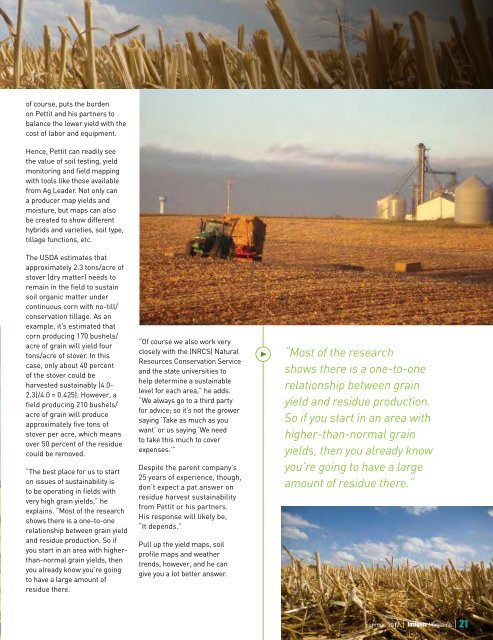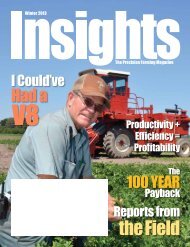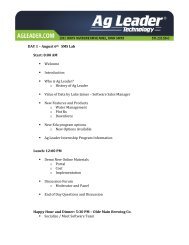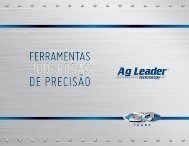You also want an ePaper? Increase the reach of your titles
YUMPU automatically turns print PDFs into web optimized ePapers that Google loves.
of course, puts the burdenon Pettit and his partners tobalance the lower yield with thecost of labor and equipment.Hence, Pettit can readily seethe value of soil testing, yieldmonitoring and field mappingwith tools like those availablefrom <strong>Ag</strong> <strong>Leader</strong>. Not only cana producer map yields andmoisture, but maps can alsobe created to show differenthybrids and varieties, soil type,tillage functions, etc.The USDA estimates thatapproximately 2.3 tons/acre ofstover (dry matter) needs toremain in the field to sustainsoil organic matter undercontinuous corn with no-till/conservation tillage. As anexample, it’s estimated thatcorn producing 170 bushels/acre of grain will yield fourtons/acre of stover. In thiscase, only about 40 percentof the stover could beharvested sustainably (4.0-2.3)/4.0 = 0.425). However, afield producing 210 bushels/acre of grain will produceapproximately five tons ofstover per acre, which meansover 50 percent of the residuecould be removed.“The best place for us to starton issues of sustainability isto be operating in fields withvery high grain yields,” heexplains. “Most of the researchshows there is a one-to-onerelationship between grain yieldand residue production. So ifyou start in an area with higherthan-normalgrain yields, thenyou already know you’re goingto have a large amount ofresidue there.“Of course we also work veryclosely with the (NRCS) NaturalResources Conservation Serviceand the state universities tohelp determine a sustainablelevel for each area,” he adds.“We always go to a third partyfor advice; so it’s not the growersaying ‘Take as much as youwant’ or us saying ‘We needto take this much to coverexpenses.’”Despite the parent company’s25 years of experience, though,don’t expect a pat answer onresidue harvest sustainabilityfrom Pettit or his partners.His response will likely be,“It depends.”Pull up the yield maps, soilprofile maps and weathertrends, however, and he cangive you a lot better answer.“Most of the researchshows there is a one-to-onerelationship between grainyield and residue production.So if you start in an area withhigher-than-normal grainyields, then you already knowyou’re going to have a largeamount of residue there.“Summer 2012 | Insights Magazine | 21
















